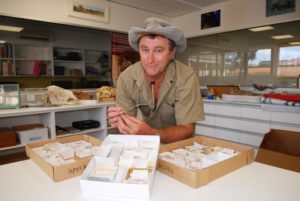
A ‘flamingo duck’ never before seen in Australia not only lived here, but strutted its stuff for millions of years after the rest of its kind died off.
That’s the unexpected finding of palaeontologists who say a member of the presbyornithid family of birds Wilaru tedfordi was thriving Down Under for up to 24 million years after the rest of its kind had vanished.
“Elsewhere in the world these ancient waterfowl existed from about the end of the age of dinosaurs until about 48 million years ago,” said Flinders University researcher Dr Trevor Worthy, who was part of the research team.
“In Australia, we discovered its bones in late Oligocene rocks, which makes this bird about 26-24 million years old.”
Dr Worthy said the discovery had come as a shock, but that Australia was well known for harbouring species whose relatives were long lost elsewhere.
He said that when first described a few years ago, Wilaru was thought to be related to stone-curlews but that the new research, published in Royal Society Open Access, showed it was actually from waterfowl (Anseriformes) lineage.
“I knew when I first examined these fossils that they were not of shorebirds but of waterfowl, but I was still astounded to conclude they were from presbyornithids,” said Canterbury Museum’s Dr Vanesa De Pietri, who led the research and did the work at Flinders University.
“Wilaru was most similar to the South American presbyornithids, but while it appears to have gone extinct in Asia, North America and South America before 45 Ma, they survived in Australia much longer,” said Dr Worthy.
“Another remarkable thing about them is that in Australia they lived beside typical waterfowl like ducks, while in all other places that presbyornithids lived there were no other waterfowl because ducks and geese had yet to evolve.”
Dr Worthy said Wilaru’s short legs suggested it was evolving to be a non-wading bird but that the number of fossils in one deposit showed it still lived in huge flocks like its ancestors.
“The terrestrial adaptations of Wilaru should perhaps not come as a big surprise, considering that much of Australia’s vertebrate fauna had to adapt to changing environmental conditions during that time,” said Canterbury Museum’s Dr Paul Scofield.
“This most exciting discovery, adding a whole new and most distinctive group to the fauna, shows how little we presently know about avian evolution in Australia,” said Dr Worthy.
“It is exciting to speculate about what else will be discovered, but as our research shows, a global perspective in its interpretation is all important.”
Dr Worthy’s research has been published this week in the Royal Society journal Royal Society Open Science.

